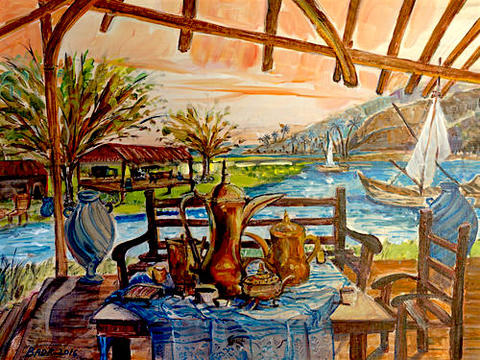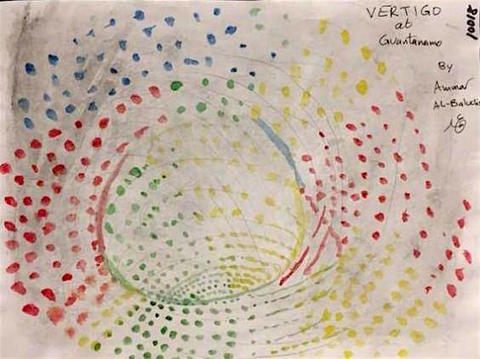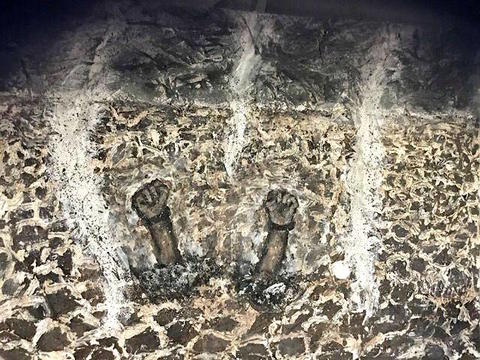The Persistent Abuse of Guantánamo Prisoners: Pentagon Claims It Owns Their Art and May Destroy It, But U.S. Has Long Claimed It Even Owns Their Memories of Torture

"Table Set for Tea," a 2016 painting by Ahmed Rabbani, who is still held at Guantánamo.
By Andy Worthington, November 22, 2017
After years of letting Guantánamo prisoners keep the artwork they have made at the prison, subject to security screening, the Pentagon has suddenly secured widespread condemnation for banning its release, and, it is alleged by one of prisoners’ attorneys, for planning to burn it.
The story was first reported on November 16 by Carol Rosenberg of the Miami Herald, and updated on November 20. Rosenberg explained how, for years, prisoners' art had been released "after inspection by prison workers schooled in studying material for secret messages under the rubric of Operational Security."
However, as Rosenberg explained, "Ode to the Sea: Art from Guantánamo Bay," an exhibition in the President's Gallery of New York’s John Jay College of Criminal Justice until January 16, 2018, which features "paintings and other works by current and former captives" — and "which garnered international press coverage" — "apparently caught the attention of the Department of Defense," because of an email address provided for people "interested in purchasing art from these artists."
A Pentagon spokesman, Air Force Maj. Ben Sakrisson, said on November 15 that "all Guantánamo detainee art is 'property of the U.S. government' and 'questions remain on where the money for the sales was going.'" At the prison itself, Navy Cmdr. Anne Leanos said in a statement that "transfers of detainee made artwork have been suspended pending a policy review."
Prisoners’ attorneys discovered the change in policy during recent visits to their clients, when prison staff suddenly "stopped returning art that had been submitted for inspection and release." Rosenberg added that, according to two attorneys, "a commander told general population captives" (i.e. not the "high-value detainees") that "they would no longer be allowed to give it away."
One of the attorneys, Ramzi Kassem, a professor at City University of New York School of Law whose legal clinic represents Guantánamo prisoners, said that one particular prisoner was told "art would not be allowed out of the prison," and added that, if any prisoner were to be allowed to leave Guantánamo (which, crucially, has not happened under Donald Trump), "their art would not even be allowed out with them and would be incinerated instead."
Another attorney, Beth Jacob, said that another prisoner had "told her by telephone from the prison that 'the colonel' announced that 'they could continue to make art. But the number of pieces each could have would be limited, and excess ones would be discarded.'"
Jacob was also told, "Not only were the captives no longer to give their lawyers works of art as gifts, but the prison would no longer let the International Red Cross receive artwork for their families." According to the prisoner’s account, the unidentified colonel told prisoners that the change in policy "was at the direction of someone not at Guantánamo," which I can only presume means that it was dictated by someone in the Trump administration in Washington, D.C.
Rosenberg noted that the change in policy contravenes Federal Bureau of Prisons policy, which "lets its inmates mail 'arts and hobbycraft' to family, give them to certain visitors and sometimes display it in public space, if it meets the warden’s standard of taste."
At Guantánamo, however, it is rare for prisoners — nearly all held without charge or trial, with some about to enter their 17th year of imprisonment — to receive any perks that might be taken for granted by prisoners on the U.S. mainland, who begin their imprisonment with a court conviction, and who, unlike the Guantánamo prisoners, are allowed family visits.
As Andrea Prasow of Human Rights Watch stated in a powerful tweet, the development was "no surprise" because the "Pentagon has long claimed it owns detainees' own memories of torture." She was referring in particular to the "high-value detainees," brought to the prison from CIA “black sites” in September 2006, whose every word to their lawyers in the eleven years since has largely remained classified, but even for general prisoners, everything they say to their lawyers remains presumptively classified until the lawyers' notes are reviewed by a Pentagon censorship team, which decides whether or not what the prisoners say can be made public.
Erin Thompson, Assistant Professor of Art Crime at the John Jay College of Criminal Justice, who curated the exhibition, which includes art from eight current or former prisoners, told the Independent that she "arranged the exhibit as a means of providing an insight into the minds" of the prisoners. She said it was "important to show the men as human beings, regardless of what they had or had not done."
"Art is supposed to be a window into the soul," she said, adding that the authorities were "'shooting themselves in the foot' if they were ignoring the art works produced by the prisoners."
How did the prisoners get to make their art?
Explaining how the Guantánamo prisoners came to make any art at all, after the early years of the prison, when they were denied almost all "comfort items," Carol Rosenberg stated that "art classes were among the first programs offered to the captives in the later years of the Bush administration as commanders explored ways to distract detainees who had spent years in single-cell lockups from getting into clashes with the guards." She added, "Students would be shackled to the floor by an ankle inside a cellblock in Camp 6 and draw still-life displays or copy a picture set up by an Arabic linguist tasked to teach art."
Rosenberg also stated, "Commanders called it the prison’s most popular, best attended program and would display examples, copies of original art, in a prison storage facility for books. Some showed seascapes and scenes from the home countries of the captives because, their attorneys said, the detainees knew it would be forbidden to show life at Guantánamo."
As time passed, "Supplies became more bountiful. Captives at times were allowed to create art on the communal cellblocks, and drew their inspiration from elsewhere. At the John Jay exhibit, two different detainees had paintings of the Titanic. The detention center had permitted prisoners to watch the 1997 disaster epic whose theme song is 'My Heart Will Go On.'"
The two artists are Muhammad Ansi (aka Mohammed al-Ansi), a Yemeni who was released in Oman just before President Obama left office, and Khalid Qasim (aka Qassim), who is still held, and is one of the hunger strikers who claim that the Trump administration is now neglecting them, and, having abandoned trying to feed them, is no longer even monitoring their health. Qasim, the art show’s website explains, "frequently experiments with the limited range of artistic materials Guantánamo affords; he has painted in coffee and on sand and gravel gathered from the prisoners' exercise yard, and has created sculpture from various discarded materials, including MRE boxes."
Another prisoner who has explored the use of materials is Moath al-Alwi (aka Muaz al-Alawi), another Yemeni. He has "used castoff cardboard and other found objects to craft increasingly large models of ships he’d only seen in books." Beth Jacob said that, the first time he met her, "he presented her with a replica gondola," and the show’s website explains that his works "are intended as presents for his lawyers and family."
Ramzi Kassem explained that all the artwork that has been released from the prison "has gone through rigorous censorship and contraband review," adding that officials took an X-ray of Alwi’s model ships before allowing them to leave.
Other works in the exhibition are by released prisoners Ghaleb al-Bihani, a Yemeni who, like al-Ansi, was released in Oman in January 2017, Djamel Ameziane, who was repatriated to Algeria in 2013, and Abdualmalik (Alrahabi Abud) (aka Abd al-Malik al-Rahabi), a Yemeni who was released in Montenegro in 2016. He is featured in a very worthwhile PBS broadcast on the prisoners’ art that is available here.
Apart from Moath al-Alwi, the only prisoners still held whose work is displayed are Ahmed Rabbani, who is currently taking the government to court regarding its new policy regarding hunger strikers, and Ammar al-Baluchi, a "high-value detainee," who painted the picture below, "Vertigo at Guantánamo."

"Vertigo at Guantánamo" by Ammar al-Baluchi, making reference to "the lingering physical effects of his torture."
Al-Baluchi is one of five “high-value detainees” held in CIA “black sites,” who are involved in interminable pre-trial hearings for the alleged role in the 9/11 attacks, but as Alka Pradhan, part of his legal team, explained in a tweet when posting this image, "Real reason @DeptofDefense wants to control @BaluchiGitmo’s art? He paints his deterioration from @CIA torture."
Clive Stafford Smith, the founder of Reprieve, told the Independent that the U.S. authorities "had always censored art they considered sensitive," and cited the example of a piece of art that Ahmed Rabbani had shown him, of him being tortured. He said that, "without giving a reason, the authorities at Guantánamo refused permission for that drawing to leave the prison."
And so, as happened back in 2008 with censored drawings by the Sudanese prisoner and journalist Sami al-Haj, Stafford Smith "made a detailed note of the painting, and when he returned to Britain, he asked several artists and art students to recreate the drawing." The version shown below is by a student from Colfox Academy in Bridport, Dorset, showing his interpretation of Rabbani’s art recreating his experience of being subjected to "a medieval form of torture, known to the Inquisition as the 'strapped.'" As Rabbani explained to his lawyers, "They took me to a room and hung me by my hand to an iron shackle where my toes hardly touched the ground. They removed the mask away from my face and left me hanging from one hand, naked, thirsty, and hungry."

An interpretation of Ahmed Rabbani's painting showing him undergoing "strapped" torture, which the U.S. authorities refused to release. This interpretation, based on a description by his lawyer, Clive Stafford Smith, was painted by a student at the Colfox Academy in Bridport, Dorset.
Who owns the prisoners’ art?
In dealing with the question of the art’s ownership, Maj. Sakrisson "suggested the art was not the captives' to give away," as Carol Rosenberg described it. In a statement, he said, "Items produced by detainees at Guantánamo Bay remain the property of the U.S. government." He also added, in a sentence that is difficult to read to the end because it is such bland admin-speak, "The appropriate disposition of this property has been clarified with our staff at the detention facility and will be accounted for according to applicable local procedures in the future."
Beth Jacob told the Miami Herald that "she hadn’t heard of the possibility that somebody at the Pentagon was alarmed to discover the detainee art was for sale." She explained that one of the former prisoners resettled in Oman "wanted his artwork sold so proceeds could go to his ailing mother in Yemen for costly medicine."
At Guantánamo, Cmdr. Leanos "would neither confirm nor deny the prison’s plans to burn the art. Nor would she say how many works of art a captive could keep and how many he would have to designate for destruction." In the meantime, as though unable to recognize that anything untoward had happened, she added that "art classes continue to be held each week and detainees have the opportunity to attend."
As Rosenberg also explained, "The art program had been such a point of pride at the prison that instructors posted copies of the work on the walls of a library storage facility, and journalists being escorted through the prison were encouraged to photograph it." In addition, "Two years ago, the prison’s now-defunct newsletter, The Wire, showed an Army officer admiring copies of the 'vibrant paintings.'"
The article about the prisoners’ art was unambiguously titled, "Program enriches detainee life."
Rosenberg also noted that the practice of releasing art from Guantánamo "had become so common that prison staff recently printed a form for attorneys to attach to have each work of art reviewed and assigned each piece a tracking number for the clearance process."
Beth Jacob, who has represented eight Guantánamo prisoners, four of whom have been released, told Rosenberg that her clients "had been using art as a diversion for some time, and had been giving her pieces for years — sometimes as gifts and in other instances to safeguard for fear that the prison would not. She cited a previous time when artwork had been confiscated, never to be returned — during the prison-wide hunger strike in 2013, when, in a raid, "soldiers seized the detainees’ artwork and legal documents from their cells." Jacob said that the legal documents were eventually returned, "but the detainees never saw that art again."
It is to be hoped that the authorities back down from their current position, which, like the treatment of hunger strikers, and the atmosphere in general, as recently described by Saifullah Paracha, the oldest prisoner in Guantánamo, seems, across the board, to have taken a harsh turn of late, presumably under directions from those at the top of the government.
Nearly 16 years after the prison opened, it is time for the U.S. government to be working out how to close this failed experiment once and for all, and not how to keep it going, whilst also making life harsher for the prisoners than it has been for many years.
To get involved, please sign this petition by Erin Thompson, "Stop the Destruction of Art at Guantánamo," and you can also sign this petition by Reprieve, calling for Donald Trump to close Guantánamo, and to allow independent medical experts to visit and assess the health of the hunger strikers. Please also read Erin Thompson’s fine article about why she staged the exhibition, in the Paris Review last month.




